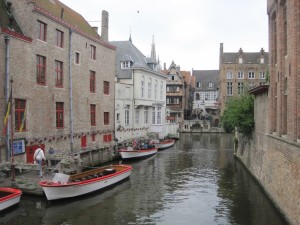An hour’s train ride from Brussels transports you back to the Middle Ages. As a UNESCO World Heritage Site, Bruges (it rhymes with “rouge”) must maintain its historic architecture in the Old Town with no modern changes. It’s known as the “Venice of the North,” with an abundance of canals that flow slowly through the heart of town, passing buildings with crenulated gables and fancy brickwork.
Bruges was once one of Europe’s wealthiest cities and its cultural capital. In the 14thcentury, its population rivaled that of London. Because of waterways that led to the North Sea, ships were able to enter the city, allowing its textile trade to flourish. Unfortunately in the 16th century, river silt clogged the harbor and the town declined. But happily in the 1980s, travelers found another way into Bruges, spurring a present-day financial boon.
The imposing Gothic structures on Bruges’ Market Square (once a harbor for ships) reflect the town’s earlier prosperity. Enter the elegant Town Hall to view the lavish assembly hall. Close by is the Belfry and Cloth Hall where you may climb 366 spiral steps to its tower for a spectacular vista of the area. Or enjoy the bells from below as a carillonist performs summer concerts on Monday and Wednesday evenings. Located in a modest corner of the square is the Basilica of the Holy Blood. The small church displays a relic of Christ’s blood that they claim was delivered from the Second Crusade in 1150. A nearby church holds another religious treasure.
Michelangelo’s precious Madonna and Child is displayed in the Church of Our Lady. It’s the first and only sculpture by Michelangelo to leave Italy during his lifetime. But if you want to see the art of Bruges’ hometown son, Hans Membling, get yourself over to the medieval St. John’s Hospital, located across from the Church of Our Lady. Six of his paintings hang in a building that once tended the sick and dying. But when art and history become overwhelming, it’s beer to the rescue. Let the servers at Den Dyver Restaurant soothe you as they pair each dish of a multi-course meal with a specialty beer.
Live like royalty for a few days in the posh Kempinski Hotel. Located not far from the main square, the former Duke’s palace reopened in 2008 as a five-star hotel. Built in 1429 for the wedding of Phillip the Good and Isabella of Portugal, the castle has been brought up to date with luxurious modern amenities. But if your budget can’t absorb the hefty room rate, treat yourself to a gourmet meal in their elegant dining room instead.
It’s no secret that Bruges combines the best of the Old World with the realities of today.





